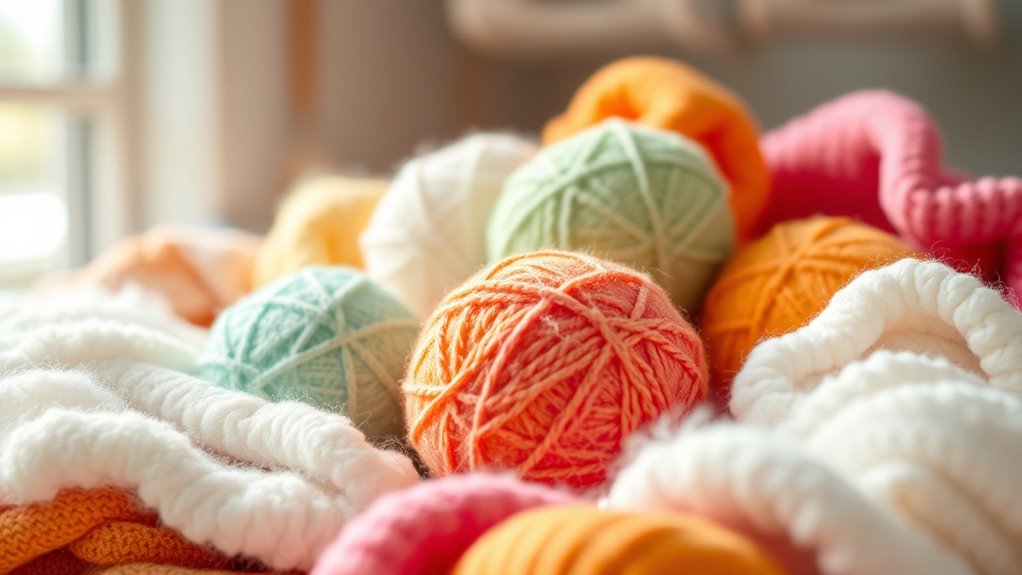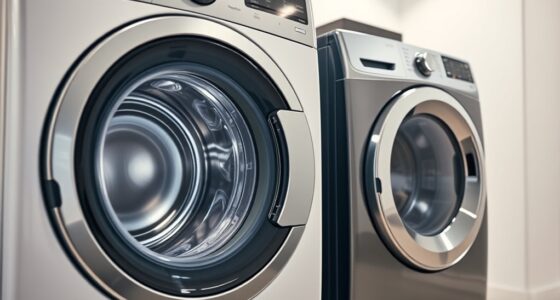Using dryer balls can help you cut drying time and decrease static cling naturally. They soften fabrics, create space between clothes, and improve hot air circulation, which speeds up drying. Additionally, they lift and separate garments, reducing static build-up and keeping clothes fluffier. Since they’re reusable and chemical-free, dryer balls are an eco-friendly alternative to traditional products. Want to discover more ways to optimize your laundry routine? Keep exploring for helpful tips and insights.
Key Takeaways
- Dryer balls create space between clothes, improving hot air circulation and speeding up drying time.
- They lift and separate fabrics, reducing static cling and preventing electrical buildup.
- Reusable and durable, dryer balls maintain effectiveness over hundreds of loads, ensuring consistent static reduction.
- By decreasing drying time, dryer balls lower energy consumption and save on utility costs.
- Mechanical action from dryer balls softens fabrics naturally, further reducing static without chemical softeners.

Using dryer balls is a simple and effective way to improve your laundry routine. When you toss them into your dryer, they work behind the scenes to soften fabrics naturally, reducing the need for chemical-laden fabric softeners. This not only benefits your clothes but also your skin, especially if you have sensitive skin or allergies. As the dryer balls bounce around, they create space between your garments, allowing hot air to circulate more efficiently. This enhances drying speed, meaning you spend less time waiting for your laundry to finish. Faster drying not only saves you time but also conserves energy, which is good for your utility bills and the environment.
One of the key advantages of using dryer balls is their ability to soften fabrics without relying on traditional softening agents. Fabric softening often involves chemicals that can irritate skin and contribute to indoor air pollution. Dryer balls, typically made from wool, rubber, or plastic, naturally lift and separate clothes during drying. This mechanical action softens fibers and reduces static cling, leaving your clothes feeling fluffy and smooth. Unlike fabric softeners and dryer sheets, which often leave residues on your clothes and in your dryer, dryer balls leave no harmful residues behind. Over time, this reduces wear and tear on your garments, extending their lifespan and saving you money.
In addition to fabric softening, dryer balls offer significant environmental benefits. Since they eliminate the need for chemical softeners and dryer sheets, you decrease the number of single-use products you buy. Many dryer sheets contain synthetic fragrances and chemicals that can pollute water systems once washed away. Dryer balls, on the other hand, are reusable and durable, lasting hundreds of loads. This means fewer products in landfills and less chemical runoff into waterways. Their ability to reduce drying time also lowers energy consumption, which translates into a smaller carbon footprint. If you’re committed to eco-friendly living, incorporating dryer balls into your laundry routine aligns with your values by reducing waste and minimizing environmental impact. Additionally, understanding the art of communication involved in explaining these benefits can help you better advocate for sustainable laundry practices.
Frequently Asked Questions
Do Dryer Balls Work With All Fabric Types?
Yes, dryer balls work well with most fabric types, providing fabric softening and reducing static. They help loosen fibers, so your clothes dry faster and feel softer. Plus, they have a positive environmental impact by replacing chemical fabric softeners and dryer sheets. You can confidently use them with delicate fabrics or heavy items, knowing they’re eco-friendly and effective across various materials, making your laundry routine more sustainable.
How Many Dryer Balls Should I Use per Load?
You should use about 3 to 6 dryer balls per load, adjusting for load size. For small loads, 3 balls usually suffice, while larger loads may benefit from 5 or 6. The ball count helps distribute heat and airflow evenly, reducing drying time and static. Keep in mind, using the right number guarantees efficiency without over-crowding your dryer, so match the ball count to your load size for best results.
Can Dryer Balls Damage My Dryer?
Sometimes, it seems like small things can cause big problems—like dryer balls damaging your dryer. Rest assured, if you follow dryer ball safety tips and guarantee proper dryer maintenance, they won’t harm your machine. Using gentle, non-abrasive dryer balls and avoiding overloading can prevent issues. When you care for your dryer, these eco-friendly tools work effectively without risking damage, helping your laundry stay fresh and your dryer last longer.
Are There Any Scent Options for Dryer Balls?
Yes, there are scent options for dryer balls, giving you various fragrance choices. You can buy scented dryer balls infused with essential oils or add a few drops of your favorite fragrance to unscented ones. This way, your laundry smells fresh and delightful. Just be sure to choose oils compatible with your dryer balls and avoid over-saturating them to prevent any damage or residue.
How Often Should I Replace My Dryer Balls?
Think of your dryer balls as loyal teammates in your laundry routine. To keep their game strong, replace them every 1,000 to 1,200 loads or roughly every 6 to 12 months. This replacing schedule guarantees maximum dryer ball longevity and prevents wear that could reduce their effectiveness. Keep an eye on cracks or flattened spots, and when they show signs of aging, swap them out to maintain fresh, static-free laundry.
Conclusion
So, next time you toss in those dryer balls, remember—they might just turn your laundry day into a surprisingly static-free, quicker ordeal. Ironically, what seems like a simple trick could save you time and static, yet still leave you battling those stubborn wrinkles and endless loads. Who knew that a few felted spheres could transform your drying routine into a game of patience and surprise? Sometimes, the smallest changes make the biggest difference—just don’t forget to admire your static-free victory.









